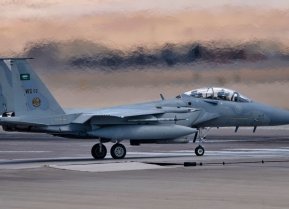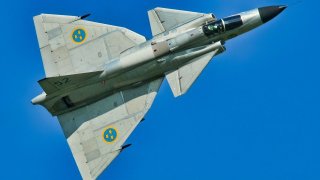The Saab S37 Viggen Fighter Had One Mission Only
The Saab S37 Viggen had a long and admirable service record and served the Swedish government well in the days when the Cold War was arguably the most intense. It never saw actual combat, but its capabilities enhanced homeland defense in the years when Sweden greatly needed it.
The Saab S37 had all of the design features to take on Russia - or then the Soviet Union - if World War III had broken out in Europe. Thankfully, that never happened:
Sweden is not the first country that comes to mind when the topic is making and flying fighter planes that could thwart the Soviets during the Cold War.
But the Saab S37 Viggen or “Thunderbolt,” aimed to do just that and it met and exceeded home defense challenges handily.
Sweden was neutral during the Cold War, but the Swedes always feared they could be the victim of an over-spill of fighting in the air if hostilities ensued in northern Europe. The Viggen was designed to give them better protection – a kind of alarm system for the country’s defense.
Brief History of the Viggen
The Viggen was a single-seat, single-engine fighter with a distinctive shape and multirole capabilities. Development began in 1952 and the airplane had a low double delta wing with canards. It first flew in 1967 and was issued to the Swedish Air Force in 1971. At the time it was quite ahead in terms of technology compared to other European fighters.
Variants Had Multiple Roles
Different S37 Viggen variants excelled depending on the mission. One model was for reconnaissance. The other had responsibilities to seek out and destroy ships. Then another variant was for all-around air superiority.
Admirable Specs
Viggens also featured the ability to make short-take-offs and landings on smaller airstrips. A Volvo RM 8 turbofan engine based on a Pratt & Whitney model for commercial airliners had an afterburner and thrust-reversers for better landing. This Volvo yielded an admirable maximum speed of MACH 2.1. It had a ceiling of 59,000 feet, a range of 1,200 miles, and could climb at a rate of around 600 feet a second.
It Had an Early and Effective Flight Computer
The Viggen’s onboard computer was ahead of its time that integrated air defense systems and controls. It also had one of the early heads-up displays. This reduced the number of crashes and eliminated the need for a back-set navigator.
The Radar Precluded the Need for a Navigator
The Ericsson PS-37 X radar gathered data in air-to-ground and air-to-air offensive modes. It enabled a greater ability to search and track. The later versions of the Viggen had better avionics and electronic and digital parts, further improving capabilities and maneuverability.
It also had a nice package of weapons with a close-in cannon and hardpoints for missiles and bombs under the wings and fuselage. It carried some of the early short and medium-range air-to-air missiles.
Stayed in the Air Continuously
Even though Sweden was neutral, there were times when the Soviet air force encroached on Swedish air space. The Viggen was thus manned by pilots 24/7 and flew in all weather. It could fly multiple sorties every 24 hours.
Did The S37 Really Intercept an SR-71?
Viggens were involved in a noteworthy exploit in 1987. An SR-71 Blackbird was flying over the Baltic Sea. The Blackbird had been flying a recon mission from England to Estonia, Latvia, Lithuania, and Kaliningrad. Viggen fighter pilots liked to practice intercepting the American ultra-fast recon plane. The incident began when an SR-71 lost one of its engines failed. The airplane fell to 25,000 feet and wandered over Swedish air space. So, the Viggens escorted the Blackbird in case a wandering Soviet fighter came into play. For these actions, the Swedish pilots were recognized in 2018 and received American air medals.
The Saab S37 Viggen had a long and admirable service record and served the Swedish government well in the days when the Cold War was arguably the most intense. It never saw actual combat, but its capabilities enhanced homeland defense in the years when Sweden greatly needed it.
About the Author
Brent M. Eastwood, PhD, is the author of Humans, Machines, and Data: Future Trends in Warfare. He is an Emerging Threats expert and former U.S. Army Infantry officer. You can follow him on Twitter @BMEastwood.


